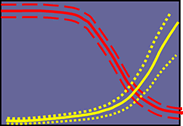
International Workshop on Uncertainties in Nonlinear Soil Properties and their Impact on Modeling Dynamic Soil Response
Sponsored
by the National Science Foundation
and PEER Lifelines Program
PEER Headquarters, UC Berkeley,
March 18-19, 2004
Day
2 Agenda
Friday March 19, 2004
| 7:10 am | Bus leaves hotel for Richmond Field Station |
| 7:30-8:00 | Continental Breakfast |
| 8:00-9:30 | Concurrent Breakout Session 1: Unresolved Issues |
| BO#1 | Site Response Analysis – User’s View |
| BO#2 | Site Response Analysis – Developer’sView |
| BO#3 | Constitutive Material Models |
| BO#4 | Soil Material Testing |
| 9:30-10:00 | Break |
| 10:45-11:15 | Plenary – Break Out Session Reports & General Feedback |
| 11:15-12:15 | Concurrent Breakout Sessions (continued) – Finalize Recommendations |
| 12:15-1:30 | Lunch |
| 1:30-3:00 | Concurrent Breakout Session 2: |
| BO#5 | Cross-Cutting Group 1 |
| BO#6 | Cross-Cutting Group 2 |
| BO#7 | Cross-Cutting Group 3 |
| BO#8 | Cross-Cutting Group 4 |
| 3:00-3:30 | Break |
| 3:30-4:30 | Plenary – Break Out Session Reports & General Feedback |
| 4:30-5:00 | Concurrent Breakout Sessions (continued) - Finalize Recommendations |
| 5:00-5:30 | Plenary – Recap Final Workshop Recommendations and Future Directions |
BO#1
through BO#4 – Unresolved Issues
Each morning breakout group should discuss current uncertainties and
needs from within their area of specialty, as well as the research
priorities for both the near-term (3-yr) and the long-term (10-yr).
This information will be presented and discussed in plenary session.
BO#5
through BO#8 – Cross-Cutting Groups
Participants will be assigned to one of four cross-cutting groups that
include people representing each of the specialty groups from the morning
break out sessions. Each break out group will be asked to discuss and
present their views on the following:
- What are the top 5 research priorities required to achieve more reliable site response predictions?
- How should testing difficulties (e.g., disturbance, equipment limitations, stress paths, anisotropy, etc.) be addressed?
- How should spatial variability of soils (e.g., vertical and horizontal variations in layering, material uncertainties within a strata) be handled?
- How should site response and material models be validated/calibrated (e.g., arrays, blasts, centrifuge, seismological studies, etc.)?
- What are the limitations of current site-response analysis models (e.g., equivalent-linear vs. nonlinear, 1-D vs. 2-D)? How significant are these limitations relative to the uncertainty in the input motion (e.g., where the motion is input into the soil column, how many motions to use, how to scale motions)?